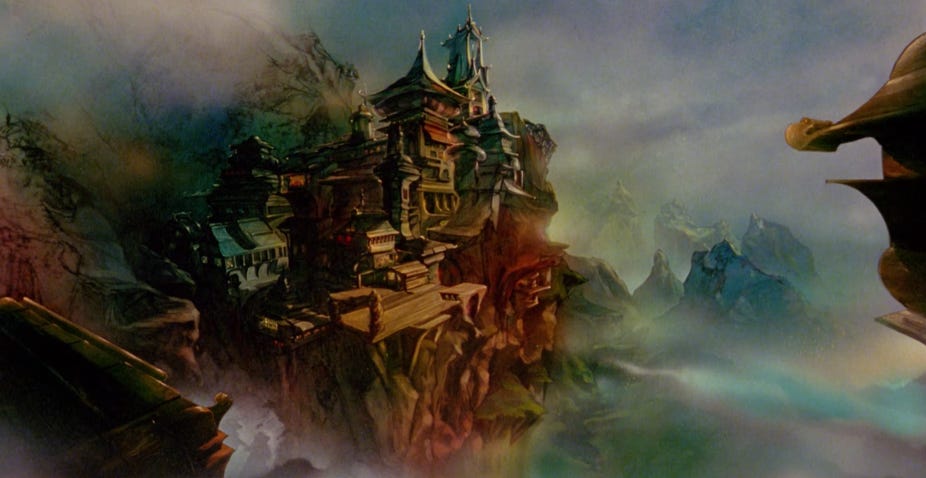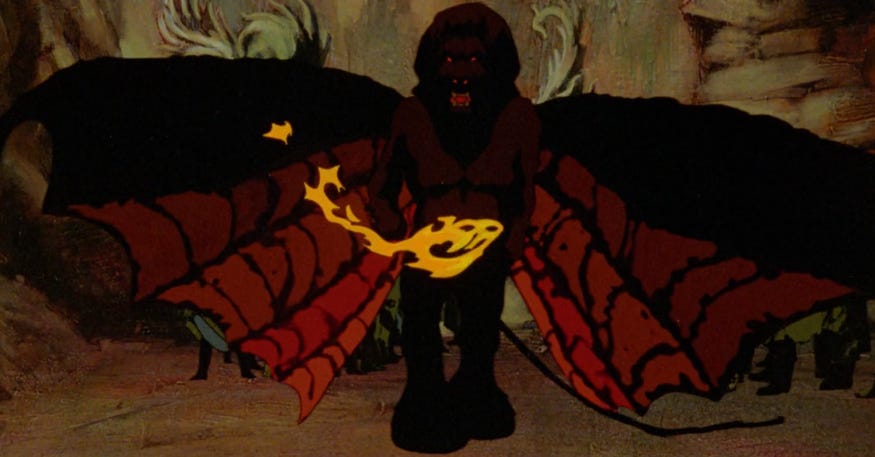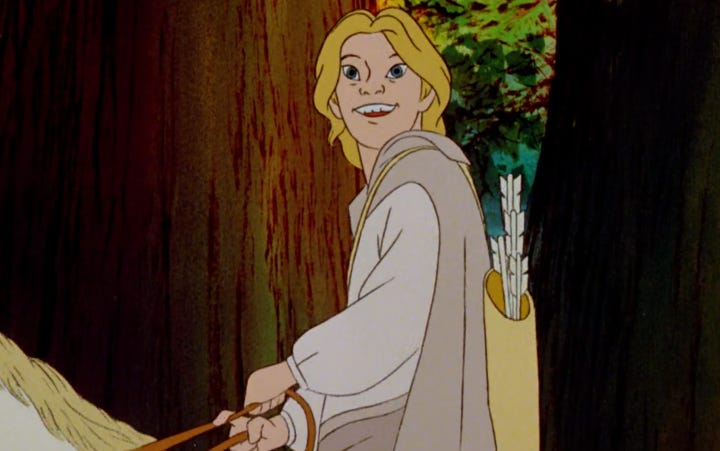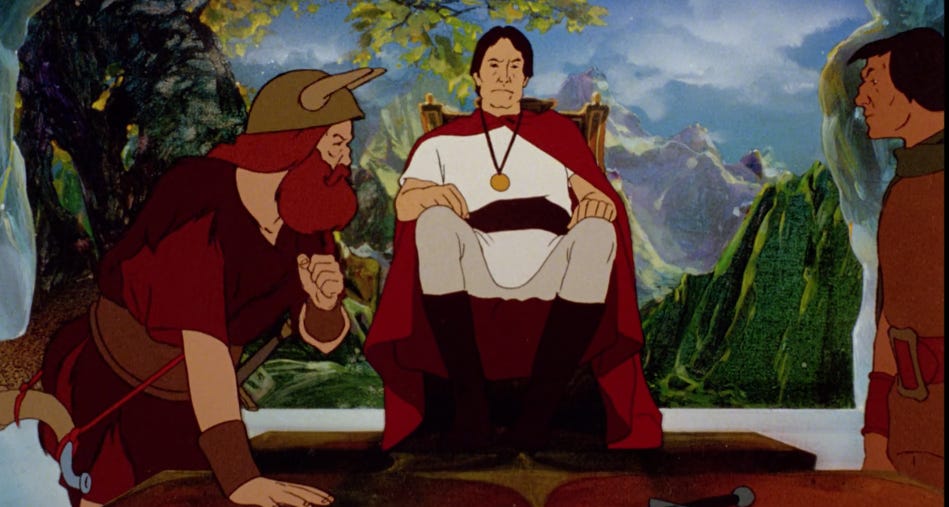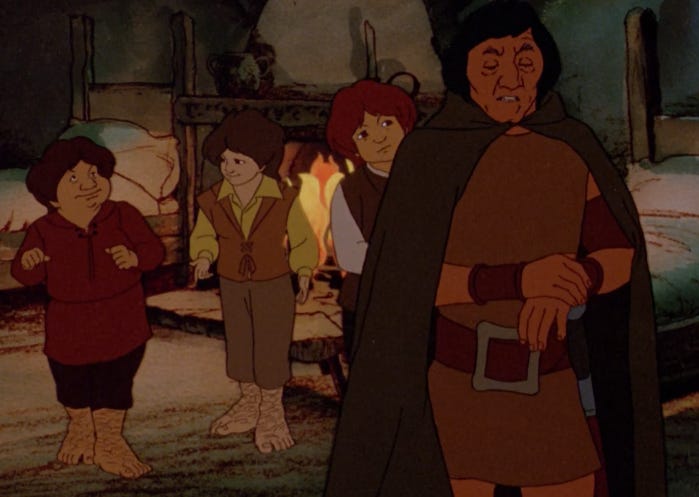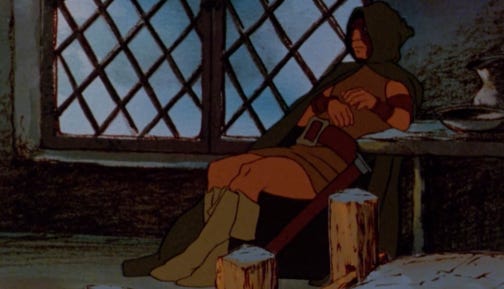Lord of the Rings Adaptations: Bakshi, 1978
What causes an adaptation to fail?
Jude: I know some readers are eager for a new pair of books, but…not yet! We’ve been wanting to do a sub-series on adaptations. Dune and Lord of the Rings have both been adapted several times over the years. The quality of these is, uh, varied at best, but the goal here is not to make fun of them, it’s to think about how well these famous stories translate into other mediums and the artistic choices made by those adapting them.
Thomas: Speak for yourself. I intend to make fun of them. Especially this first one.
Jude: Yes, well, we’re going to do these adaptations in chronological order, so first up is 1978’s Lord of the Rings, directed by Ralph Bakshi. We never actually watched this movie until now despite being huge Lord of the Rings fans in our youth.
Thomas: Its reputation was one of artistic and commercial failure. I read enough about it to remember that contemporary critics weren’t happy about the rotoscoping. I didn’t really know what “rotoscoping” was but I knew that people felt very strongly about this. Finally, I knew it was directed by Ralph Bakshi, but I thought his name was spelled “Bakashi” and only just now learned the correct spelling.
Jude: Bakshi got his start doing edgy, adult-audience animated films before doing children’s fantasy instead. I guess Fritz the Cat is his most successful movie? I’ve vaguely heard of that and I read an article calling Wizards fascist many years ago, but I was surprised to read his Wikipedia article and not even recognize his older work. I guess it wasn’t until the 1980s that there were strong Disney alternatives for American animated films.
Thomas: I don’t think we need to belabor the intro here. We have now seen this movie for ourselves, and the verdict is clear. Despite what the conventional wisdom would have you believe, this movie is actually…yeah, okay, sometimes the conventional wisdom is completely correct. This is an extremely bad movie. Let’s start making fun of it, because what else is there to say?
Jude: Not so fast. Let’s see if we agree on the reasons why it’s bad. Despite its many faults, this is still recognizably Lord of the Rings, one of the most popular books of all time. Some people said it was simply unfilmable, but two decades later it was made into an extremely popular trilogy. So what’s the problem here? “It sucks”…but why? If Lord of the Rings is super popular and good, how come it sucks in this form?
Thomas: This could be our longest post yet. Where do we even start?
Jude: One massive problem at the outset is that it tries to cram Fellowship of the Ring and most of Two Towers into a single two hour movie. If you asked me twenty years ago to guess why it failed, that’s probably what I would have said. You just can’t do justice to this story in such an abbreviated form.
Thomas: Yeah, if only Tom Bombadil was in there, that would have really saved it.
Jude: You joke, but when Peter Jackson started working on his movies, there were fans who were convinced Tom Bombadil was an essential piece of the story.
Thomas: Obviously he’s not. Jackson dropped him and only the truly fanatic missed him. What about that scene where the fellowship hides from flocks of birds and decides to head for the snowy pass at Caradhras? That was in Jackson’s Fellowship but not in Bakshi’s film. It’s a good scene. But is it fatal to miss it?
Jude: The many extra moments Jackson has time for definitely help us to get a feel for the many characters. In Bakshi’s film, Merry and Pippin get absolutely no characterization. Nor do Legolas and Gimli. Even Sam is a cipher, getting only a couple lines before the breaking of the fellowship. It’s really only Frodo, Gandalf, Aragorn, and Boromir that come through with any clarity. So most of the cast certainly suffers.
Thomas: There’s also no time for explanation. Where is Mordor? Who is Saruman? What is a hobbit? Bakshi’s film doesn’t have time to explain what hobbits are and they often seem like children. Pippin sucks his thumb after dropping the rock in Moria, so even the animators didn’t realize he isn’t supposed to be a little kid! The choice to send Frodo out of Rivendell on his dangerous mission is a bit dodgy in Tolkien’s book, actually, but at least there’s the some implication that Frodo has proven unusually resistant to the ring’s corruption. Here, it’s child abuse.
Jude: Right, but suppose the viewer has read the books. We certainly have! No explanations needed for us. We know where Mordor is and who Saruman is. Did we like it?
Thomas: Hell no.
Jude: Why not? The overall plot is very faithful to the original, despite some omissions. A great deal of the dialogue, much more by percentage than in Jackson’s films, is lifted straight from the book. When we eventually come to discuss Jackson’s films in detail, we’re going to say that the dialogue cribbed from Tolkien is by far the best. So why doesn’t it work here?
Thomas: If you want a theory of what’s wrong here, I’ll give you one. It’s just flat-out poorly executed. We’re not film experts and this isn’t a film site, so we might be missing some vocabulary but I’ll try to run through some of the major problems.
First, the infamous rotoscoping. It’s not always bad. But often it is, and sometimes it’s very bad indeed. There’s no internal artistic reason for the sometimes dramatic shifts between what appears to be hand-drawn animation (traced against rotoscoped originals), footage that looks much more like blurry video than animation, and then a third style where you have silhouetted people in front of drawn backgrounds.
But I think much worse than the rotoscoping itself is the way it’s animated in the majority hand-drawn style. Again, I might be missing some vocabulary, but the characters are always moving and shifting. That’s a problem because there’s often a lot of characters on screen and when they’re all moving at once, what should I look at? Who is the focus of the scene? Sometimes it’s not even clear which character is speaking.
Worse, the characters move in unnatural ways. Facial expressions especially feel like they are linear interpolations that play out across several seconds between two very different points. I’m not sure how human expressions change, but they don’t change at a constant rate, that’s for sure. The whole thing has this creepy, liquid feeling. Just to make sure I wasn’t holding it to some recent film language, I pulled up some clips from Disney’s Robin Hood, released a few years earlier, and sure enough, it might show its age a bit but it was massively easier to watch, both in terms of viewer focus and in legible facial expression.
But that’s not all! Even besides the constantly shifting facial expressions, the acting is bad.
Jude: I actually thought the voice acting was…okay? The performances aren’t great, but they aren’t terrible.
Thomas: You’re right, but I mean the physical movements of the characters. I’ve never come out of a Disney film and said, “Wow, the character movements were so good!” But it turns out they can be very bad. In this movie, too often the movements simply don’t match the way the characters are talking and feeling. Sometimes, and this might be even worse, the movements kind of match but aren’t timed very well to what is being said. Gandalf is a particularly bad offender. He loves pointing. He points over and over again. Stop pointing. Jeez.
The editing: also bad. A lot of scenes simply don’t make any sense. For example, when they are approaching Rivendell, pursued by the Black Riders, Frodo gets on Legolas’s horse. A Nazgul comes galloping towards them, brushing aside Aragorn without slowing. Legolas says “fly, fly to the ford” and then…the Nazgul stops his horse, which then just kind of stands there skittishly. Frodo and the Nazgul then sit on their horses opposite each other for almost a minute with the horses anxiously stepping sideways.
Jude: I guess it’s supposed to be tense?
Thomas: But what is happening? Eventually the rider speaks and Frodo turns and gallops away. But what was the point of all that? Why didn’t he ride away when Legolas told him to? Why did the rider stop twenty feet away instead of closing the distance?
Jude: Yeah…
Thomas: This isn’t just a one-time thing. “Don’t bar the door, we’ll be trapped!” someone says at Balin’s tomb in Moria, so they leave the doors cracked…and rush to the other side of the room. Then some orcs start to come through, so Boromir rushes the door and pushes them back with some help from Sam (I think? One of the hobbits, at any rate). Then…they just run away from the doors again to the far wall, so of course the orcs just come right through. The action just doesn’t make any sense.
Jude: I think this might have been because their process was they shot a ton of live-action footage, then went and drew over it. But they must not have had the budget for reshoots, so when editing they had to do the best they could with whatever they had shot months earlier in the live-action phase.
Thomas: Yeah but that’s most movies, at least at this time before cheap film stock and digital cameras. Part of the art of directing is making sure you get the shots you’re going to need in the editing room. Bakshi doesn’t seem to have come close to doing this correctly.
Jude: I’m not sure he had any live-action film experience.
Thomas: Then he shouldn’t have tried it on what was, for him, a big project!
Jude: We’re not sufficiently film literate to have any authority on this, but I do think that for whatever reason the craft of, let’s say, replacement-level practitioners in Hollywood has gotten a lot better over the years. A few years ago I watched “Encounter at Farpoint”, the first episode of Star Trek the Next Generation, and was shocked at how bad the direction and cinematography was in basic scenes of people talking to each other. Today, even bad TV shows usually have good editing and direction, but they had to make shows much faster back then. And Bakshi likewise seems to have been rushed and underfunded.
Thomas: Well, the tragedy of the film industry is that a huge number of people can work very hard and employ objectively impressive artistic talent and then, through no fault of their own, the result of years of their professional lives is a terrible movie.
Jude: So are you done ranting about the poor execution?
Thomas: No! This is animation, so what about the art? We’re not art experts either so I still have no fancy terminology. All I can say is: the art sucks. You can blame the budget for having only a single establishing shot of each place, but you can’t blame the budget for the one look we get of Rivendell looking like this:
Even leaving aside whether this is what Rivendell should look like—to be honest I never got a clear image from reading Tolkien—why is there this vaguely uniform fogginess? Why are there red accents that make a place that in the story is a safe refuge seem ominous instead? Why are some near parts of the mountain obscured and why are some distant peaks visible? Why is the lighting so different on different parts of the building that are facing in the same direction?
Jude: Maybe they wanted it to be…in the clouds? But also shadowed by some mountains we can’t see?
Thomas: Even if there’s some geography that could account for all this—though I doubt it—this is bewildering. And not the “built by an ancient race” kind of bewildering. The “this is ugly” kind.
What about the backgrounds? Here we have…something…in the background in Moria as the fellowship goes across a wooden bridge:
What the heck is that? It looks like a huge bug.
Jude: Maybe that’s the balrog.
Thomas: Alas, it is not. This is the balrog. Slightly taller than Gandalf. We’re doing animation, and he looks like a guy in a suit.
Jude: I guess with the rotoscoping, maybe he was a guy in a suit.
Thomas: Probably the standout visual moment is when we first meet Legolas. Most fans probably have a hard time shaking Orlando Bloom’s portrayal, but here’s Bakshi’s interpretation:
Jude: Uh…I mean…he is an elf. They ought to look different, right? You could argue that Peter Jackson’s elves were too close to human
Thomas: But should they look like this?
Jude: No. Definitely not. They should also have more than just four arrows, it seems to me.
Thomas: Anyway it doesn’t seem to be an elf look because here’s Elrond.
Jude: He’s only half-elf.
Thomas: Celeborn looks like Elrond, but Galadriel looks just as, uh, winsome as Legolas does. But while we’re looking at that Elrond image, I have to also point out that in this scene, the council of Elrond, while everyone else is standing around a big table, Elrond is sitting on a throne that is itself placed on the table everyone’s sitting around. It’s a very odd arrangement.
Jude: Elvish customs are different than ours.
Thomas: I think it interferes with the important moment where Frodo accepts the mission, because it feels like this king is looking down at a weak child and being like, “You know what, let’s send the kid on this dangerous mission.”
Jude: But that’s back to being an example of a lot of the necessary context being lost. The idea that a hobbit is unusually resistant to the ring and very hard to see is in the book, and going back to The Hobbit was the idea that they’re stealthy and can sneak into places—in this respect Frodo is just doing a much more elaborate riff on Bilbo’s burglar thing in The Hobbit.
Thomas: In Peter Jackson’s movie, he wisely avoids talking about racial resistance and instead makes it seem like Frodo is a compromise, a bad choice everyone is forced into because no one trusts anyone else to carry the ring. Which is also fine. Doing none of that, though, and presenting Elrond as a powerful king, makes this seem weird.
Jude: True. I want to get to my theory of what’s wrong here, so are you done with your complaints about the art?
Thomas: Just to sum up, movies combine the output from many types of artists. There are good movies where some element—writing, direction, acting, visual art—is particularly great. Great movies are great in many elements at once. Here, the movie is already deeply handicapped by the need to abbreviate its source material. The art could have helped make up for what was lost, but instead, it makes it worse.
Jude: Well, before we change the subject, I want to say that it’s not all bad. Well, it’s mostly bad. Almost entirely bad. But I do respect the approach taken with Aragorn, who is supposed to “look foul but seem fair” in the book but is presented as a young, handsome prince from minute one in Jackson’s Fellowship of the Ring (and Jackson tried to cast an even younger, prettier male actor before ending up with Viggo Mortenson). Bakshi to his credit gives us an Aragorn who hasn’t had a modeling career:
I think he’s also got a Native American vibe, which is a cool association to make for a ranger.
Thomas: Counterpoint: he doesn’t wear pants. No wonder people in Bree don’t like him. He’s a stranger who wanders in with no pants on.
Jude: He wears a toga, which is appropriate if you think of Numenor as being like the Roman Empire.
Thomas: Correction: he wears a toga with an enormous belt buckle. Meanwhile Boromir wears furs and a horned helmet even though he comes from a much warmer southern climate. Though Boromir also doesn’t wear pants. No wonder they couldn’t make it through the snow! I believe pants come directly from the Germanic tribes whose cultures were the basis of Tolkien’s human cultures in Lord of the Rings. They wore pants because it gets cold in northern Europe!
Jude: Moving off of pants, I think you’re right that overall this is movie is badly executed. But I want to propose a more nuanced explanation for why it wasn’t very successful. When we talked about why Lord of the Rings remains popular, we noted that unlike Dune which has tons of different cool elements, Lord of the Rings goes very deep on a couple factors and by evoking them repeatedly in different ways gives people multiple paths to appreciate them.
For me, the biggest was Tolkien’s emphasis on personal virtue. All four hobbits are models for personal behavior that readers can aspire to: first Frodo, then Sam, and eventually Merry and Pippin as well. I still think Aragorn is meant to be an unattainable ideal, not a relatable character, but he, Gimli, and Legolas embody important qualities as well. Many of their important moments of decision remain in the film: Frodo accepting the ring, Sam joining him to go into Mordor, Aragorn deciding not to abandon Merry and Pippin.
But squeezing so much story into so little time means these moments aren’t set up enough for them to matter. There’s little sense of what alternatives there might be or the stakes of these decisions. Aragorn promises to help Boromir’s city, but it was never explained why it needed help. Aragorn then risks Gondor to pursue Merry and Pippin, but who even are these guys? Pippin had one moment (dropping the rock in Moria and then sucking his thumb, sigh) and Merry has essentially zero.
My other components to Lord of the Ring’s popularity were the connections to the world, to the past, and to other people. In Bakshi’s film the world is almost entirely absent. There’s no time to explain anything, of course, and as you’ve said the background art is woefully inadequate to the task. The past likewise goes mostly unexplained and unevoked. And since only Frodo, Gandalf, and Aragorn really get much screentime, there isn’t much lower case f fellowship either.
Thomas: My contention was that Lord of the Rings is popular because it’s suffused with nostalgia, showing us a world that used to be better and is getting worse, and that nostalgia really resonates with people. This is also completely absent from Bakshi’s film. The idea that the elves are leaving Middle Earth, the idea (driven home by ruins at places like Weathertop) that the entire first third of the story takes place in the ruins of what used to be a prosperous kingdom, even the idea that Moria used to be beautiful and now is not…all this is gone. Only one trace survives: Galadriel saying that success in the quest will be the end of Lothlorien. But once again, there’s not even minimal setup: we haven’t seen anything of Lothlorien that would make us care about it, so big deal.
Losing that means losing an important dimension to our heroes’ determination: they can’t bring back the lost past, but they decide to fight and sacrifice to try to keep the future from being a lot worse than the present.
So unfortunately, this film fails on nearly every front.
Jude: But to return to the point about length: maybe that failure was inevitable? Certainly both before and after this movie was made, people thought it was impossible to translate Lord of the Rings to film. Maybe they were right! And while Peter Jackson’s comparative success argues otherwise, he was fortunate enough to have about five hours to cover this material, not to mention a much larger budget for artists of all kinds of help visualize things, better actors, etc. Maybe Bakshi’s task simply was impossible given the time and money he had to work with.
Thomas: Maybe. And certainly the poor artistic level was always going to hold back an animated film of this type. But at least in Japan it is common for there to be comparatively low budget anime shows that nevertheless achieve more impact with their audience than lushly animated competitors. Given everything we’ve said, I think the problem was actually that Bakshi was unwilling to really apply the razor and cut more out.
Sure, he dropped some of the initial adventures Frodo has before meeting Aragorn (as did Jackson). But why not also drop Lothlorien? In fact, why not just drop the Two Towers material entirely and go from Rivendell to Minas Tirith and Mordor and just end the story?
Jude: There’s a couple challenges. One, Tolkien fans, the only built-in audience for a movie like this, would hate to see the story butchered like that. And two, the Two Towers material is the best material. We talked previously about how Frodo and Sam’s trek through Mordor is intellectually interesting but kind of a drag to read.
Thomas: Then maybe skip the black riders, teleport Frodo to Rivendell, and then focus on the Fellowship’s adventures in Moria and then Rohan. Bring Frodo along if him being in Mordor is too much of a drag.
Jude: Not only would Tolkien fans hate Bakshi far more than they do today, you’re going to make them hate us for even suggesting this.
Thomas: All I’m saying is that if you want to do a mostly faithful adaptation, you need to commit to a length that allows it. If you’re going to make it shorter, like this movie, then that’s already out the window. People are already going to be mad you cut Tom Bombadil and whatnot. So then you have to be aggressive about cutting so that what’s left can still function. And not just function, but embody the subtle virtues we claim are the source of the story’s lasting resonance.
Jude: This is something we can come back to with Dune adaptations, I suspect, since they tend to be much more aggressively downsized. But next we’ll spend at least a little bit of time on the Rankin/Bass made-for-TV movie Return of the King (1980).
Thomas: Maybe the problem with Bakshi’s film was there weren’t enough songs.
Jude: We’ll find out.


